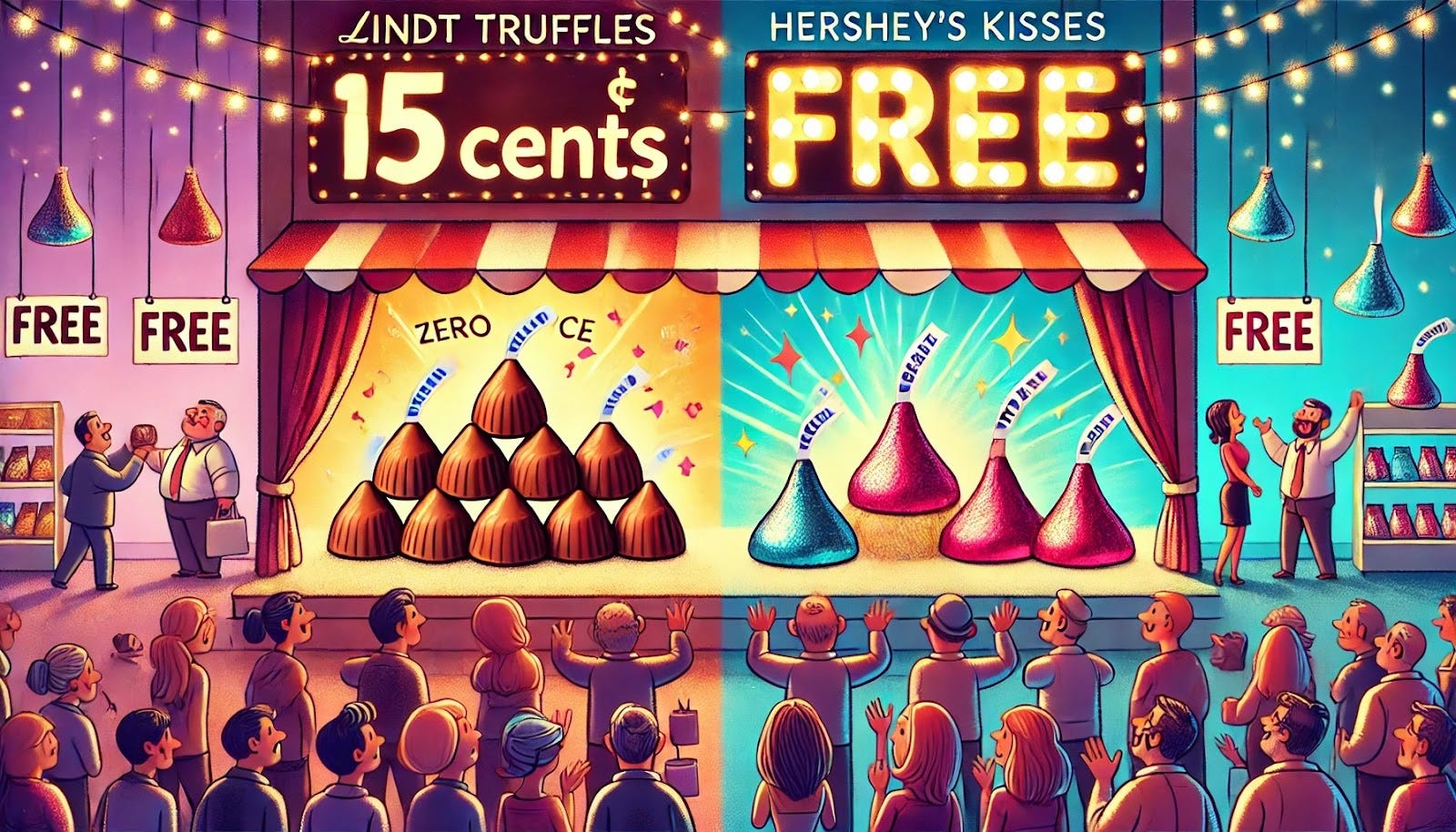Unlock Zero Price Power
Plus, 👀 Why do We Want What Others Have
Hey Readers 🥰
Welcome to today's edition, bringing the latest growth stories fresh to your inbox.
If your pal sent this to you, then subscribe to be the savviest marketer in the room😉
Unwrapping the Magic of Free: The Zero Price Effect
Insights from Stacked Marketer
What happens when pricing psychology meets chocolate? A story that’s as sweet as it is enlightening.
In 2007, Dan Ariely and his team set up a shop offering two chocolate choices: Lindt truffles at 15 cents each and Hershey’s Kisses at 1 cent each. Initially, 76% of customers opted for the luxurious Lindt truffles, a clear bargain.
Then, Ariely sprinkled a bit of pricing magic: he reduced both prices by 1 cent. Suddenly, Lindt truffles were 14 cents and Hershey’s Kisses were free. The result? 69% of customers went for the free Hershey’s Kisses.

The Power of Free
We often toss logic aside when something is free. Here’s how you can tap into this irresistible allure in your marketing:
1. Sweeten the Deal with Freebies Boost your average order value (AOV) by bundling a product with a freebie. Imagine you offer a special gift with a purchase. Not only do you delight your customers, but you also encourage them to spend more. Your small freebie becomes an investment in greater returns.
2. The Holy Grail: Free Shipping Free shipping is the holy grail for customers. Studies show people prefer it over other perks. Make “free shipping” the bold headline of your offer. Let it shine brighter than the product itself, and watch your sales soar.
3. Price Magic: Free Adjustment Reframe your pricing to highlight the free aspect. Consider this: a $50 product with $10 shipping versus a $60 product with free shipping. The latter feels like a better deal. This simple tweak makes your offer more enticing without hurting your bottom line.
Key Insights
The Zero Price Effect reveals the enchanting power of “free” in boosting sales. Use it wisely by adding free products, emphasizing free shipping, and smartly adjusting your pricing strategy. Ready to cast the spell of free in your next campaign? Share your thoughts and let’s see the magic unfold!
Mimetic Desire: The Secret Behind Why We Want What Others Have
Insights from Customer Camp
Imagine this…
You’ve planned the perfect spring break vacation with your best friend—hotels, restaurants, sunset views. But you didn't think about one thing: your sunglasses.
You packed your old Target shades without a second thought. But now, on the beach, your friend pulls out her brand-new orange aviators that put Tom Cruise’s to shame. Instantly, she catches the eye of a Liam Hemsworth look-alike who compliments her shades.
Your friend laughs, saying, “These always grab attention. Plus, the polarized lenses are way better than my old cheap ones.”
You glance at your plain sunglasses and feel frumpy. All day, no matter what you do, those orange aviators are all you can think about. Yesterday, you didn’t know they existed. Today, they’re all you want. Why?
🧠 The Psychology of Mimetic Desire
In the 1950s, French philosopher René Girard studied classic novels and noticed a pattern: characters desired things because others wanted them. This concept reveals that we rely on “models” to know what to want. These models can be people, groups, or even lifestyles.
Girard’s related concept, Metaphysical Desire, shows that sometimes we want intangible things like recognition or social status. An author wants to be on the New York Times Best Sellers list not for the list itself, but for the credibility it brings.
Takeaway: People desire something if they believe others also desire it. Smart marketers use models to showcase their product's desirability.
How to Apply This 🤑
1. Embrace Trends
Pantone’s Color of the Year influences consumer spending. Knowing which color to want amplifies its power. That’s why Apple released iPhones in Pantone’s chosen shade—twice.
2. Sell an Experience, Not a Product
BMW’s slogans, like “Sheer Driving Pleasure,” speak to desires for superior performance and prestige. BMW sells premium experience and social status, not just cars, breaking sales records with over 2.2 million cars sold in 2023.
3. Use Social Proof from Respected Models
People look to models to decide what to want, we highlight our successful alumni to show the value of our programs. Recognizing respected experts encourages others to follow suit.
Key Insights
Humans aren’t hardwired to “desire.” We depend on others to figure out what we should want. Smart marketers highlight a product’s desirability through models and social proof.
We'd love to hear your feedback on today's issue! Simply reply to this email and share your thoughts on how we can improve our content and format.
Have a great day, and we'll be back again with more such content 😍